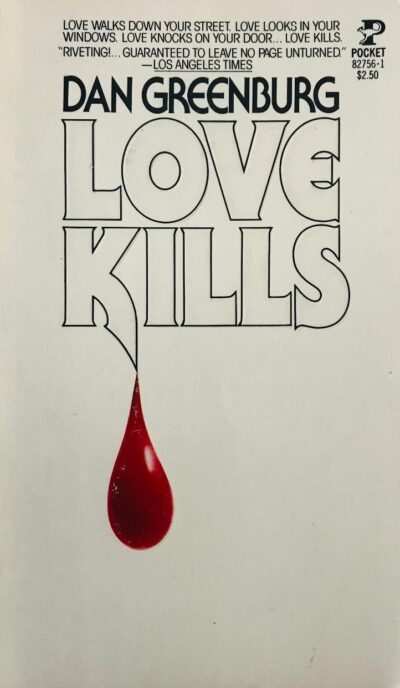 By DAN GREENBURG (Pocket; 1978)
By DAN GREENBURG (Pocket; 1978)
A serial killer epic, the first of a trilogy (completed by EXES and FEAR ITSELF), that was published a year prior to the seminal 1970s example of such: BY REASON OF INSANITY by Shane Stevens. That novel was a realistic and unflinching horror story that set a template for authors like Thomas Harris and John Sandford. LOVE KILLS stands as a wild and outrageous companion-piece to Stevens’ novel.
…wild and outrageous …
The author was Dan Greenburg, whose 1969 horror novel PHILLY was noteworthy (by me) for its darkly comedic streak (fittingly, it was adapted for the screen in the form of a sex comedy: 1980’s PRIVATE LESSONS). LOVE KILLS is similarly oriented, with a narrative drive that despite a bleak arc is lively, energetic and damn funny.
…a narrative drive that despite a bleak arc is lively, energetic and damn funny.
The subject is a New Yorker who dubs himself the Hyena, and has a most unfortunate hobby: he likes to stalk attractive women he believes he’s in love with, and then use some ruse to make contact so he can ask them out. This is as far as he ever gets, given that the Hyena’s would-be dates invariably end up dead. As the bodies pile up the city becomes increasingly on edge, putting increasing pressure on the NYPD to track down the killer.
Enter Max, a homicide cop determined to be the hero, leading to (in one of several nods forward to the modern serial killer fiction model) a lot of minutely detailed police procedural business, including reproductions of actual NYPD memos and arrest forms—yes, the author did his homework. Luckily the breathless present-tense prose, also on display (sans the present tense) in PHILLY and the 1987 horror fest THE NANNY, ensures that the novel is always a page turner regardless of how research-heavy or plain wild it becomes.
That latter attribute is evident in the wonky chronology, which often loops back on itself, as in the oft-graphic descriptions of the Hyena’s murderous encounters that often occur after we’ve learned the outcome of said encounters. Given that the entire thing is told in the present tense, this back-and-forth timestream leads to some confusion on the part of the reader.
As if all that weren’t enough, Greenburg also throws in a supernatural angle in the form of Babette, a young Catholic with psychic powers who foresees the Hyena’s killings before they occur. This lands her in a platonic relationship with Max (as her religious convictions disallow pre-marital sex), which occurs just as the Hyena turns his gaze on Babette, deciding she’ll be the latest of his would-be lovers.
A page-turner this novel undoubtedly is, but it’s an example of a format that had yet to be perfected. Shane Stevens was the author to do that, although Dan Greenburg deserves credit as, if nothing else, he got there first.
